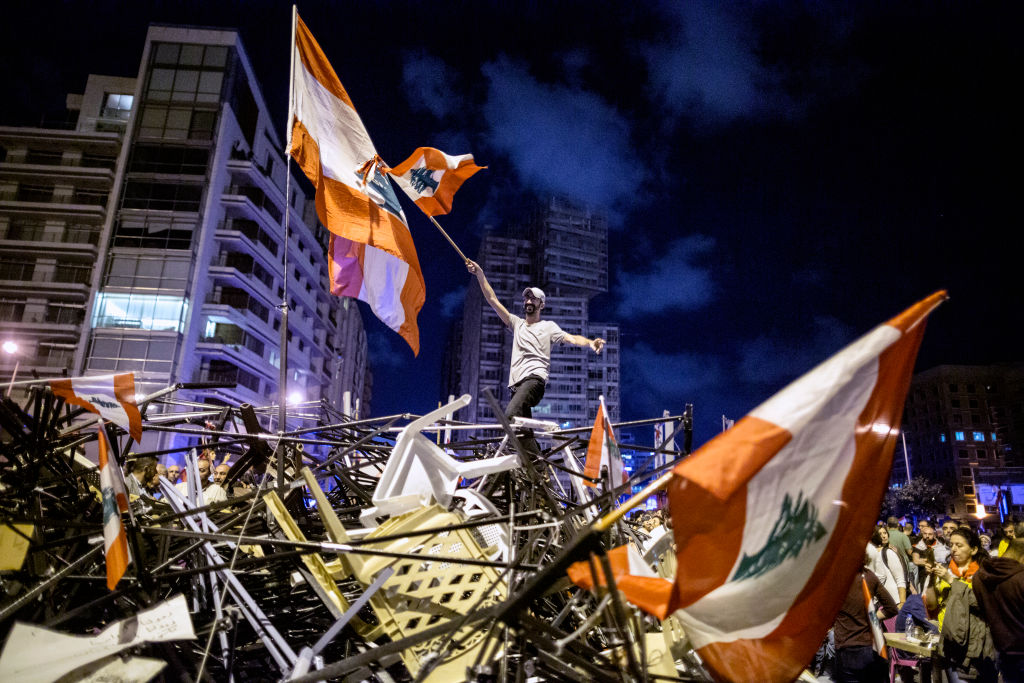It was interesting to monitor the street’s reaction to Hezbollah’s responses. When Hezbollah’s leader Hassan Nasrallah spoke for the first time during the protests, he sided with the authority against the protestors. When he spoke for the second time, it was clear that he – and his party and sponsors – are the real authority in Lebanon.
HEZBOLLAH’S MISTAKES
Siding with the authority and telling the protestors that their demands are worthless was Hezbollah’s main mistake, which has framed its position in Lebanon today and for the days to come. It has made itself clear as the main authority that decides who stays and who goes, and how the protestors should behave.
However, between the two speeches, Hezbollah has also made a number of other mistakes. Hezbollah had always been good at political maneuvers and military strategies, but they do not have any tools to deal with a true and genuine uprising. They responded the way they usually do: with violence. They have used violence against the Lebanese before in May 2008, and against the Syrians since 2011, but in 2008, they were fighting political opponents, not the Lebanese people, and in 2011, they used the Islamism extremism as a scarecrow to justify their violence.
This time around, they stumbled. Hezbollah sent its men to clash with the peaceful and unarmed protestors a number of times, but each time they failed to scare them off the streets. Because this time around, they are not dealing with a clear enemy or an extremist opponent such as ISIS or Al-Qaeda. This time around, they are fighting the Lebanese people, pure and simple. The more violence they used, and the more threats their leadership sent, the more people took to the streets, in an act of defiance against fear and sectarian rhetoric.
The most fascinating part of this process is the Shia community, which took the streets under the same Lebanese flag and with the same non-sectarian rhetoric, and with the same demands. The unity of the Lebanese people scared all the political class that has been using the same sectarian rhetoric for thirty years, but it mostly frightened Hezbollah who started to realize that they are no longer in control of the Shia community in Lebanon.
The Shia towns and cities witnessed the worst violent reaction by Hezbollah, and its partner Amal movement. However, people still came back to the streets after each violent clash and threats. They have nothing to lose anymore.
Today, two things have been clear: Hezbollah is the main enemy of the Lebanese people, and the Shia are no longer part of Hezbollah’s scope of influence. Hezbollah has been stripped of the most significant pillars of its power in Lebanon. Broadly speaking, the Lebanese people’s unity defied corruption and militia rule in the streets.

HEZBOLLAH’S OPTIONS AND CONSEQUENCES
Prime Minister Saad Hariri resigned during the second week of the protests. That was received as a big win in the streets. However, the process is longer and more complicated than a Hariri resignation.
Constitutionally, the parliament needs to make immediate consultation with the president in order to choose the next prime minister. Until then, Hariri’s government might simply become a care-taking government. Knowing that the current parliament’s composition is still a Hezbollah-majority, there is no chance that it will allow a proper transition of power. They can stall until the people get tired or until they are forced to go back home. This is an unlikely scenario because the next crisis will bring everyone back to the street; that is the economic collapse that Lebanon has been facing for many months. So eventually, this authority – that is Hezbollah’s authority – will have to deal with the repercussions of such collapse and maybe an international bailout that will eventually contain their power.
Hezbollah can use more violence, such as May 7, 2008, when Hezbollah’s militias stormed the streets of Beirut and the mountains, and for the first time, they used their arms against other Lebanese. But this will also backfire as violence has only made Hezbollah look bad and created more criticism against them in the streets. They cannot lose more than they already have.
Hezbollah can also divert this scene by starting a war against Israel, thereby using the “resistance” rhetoric and forcing the people back home. However, they will try their best to avoid this option. Their own financial crisis makes it very difficult for them to fund a war, or to deal with the reconstruction phase, especially that they will be blamed for the war this time.
Hezbollah has a number of options up their sleeve and they are exhausting one after another. But every time they act, people react. Hezbollah – by siding with the authority – has turned the Lebanese people, including its own constancy – against them. No option is a good option for Hezbollah.
These protests have already achieved many significant outcomes. Hezbollah has been stripped of its power by losing two main pillars: its public support among the Lebanese, and mainly among the Shia community, and they have also lost their political allies who politically fell in the streets: Speaker Nabih Berri and Foreign Minister Gebran Bassil. It is not a coincidence that the two most corrupt political leaders are Hezbollah’s main two allies. And it is not a coincidence that a protest against corruption turns into protests against Hezbollah.
Last but not least, what is taking place in Lebanon today is not separate from the events that are taking over Iraq’s streets, mainly in Shia areas. Two unprecedented protests that seem to be linked with the fight against corruption, are gradually turning into a fight against Iran’s influence in the region.
Iran is in a very difficult position, and no matter what happens next, it has already lost much of its power; the people. One thing is clear, there is no going back to square one.
Hanin Ghaddar is the inaugural Friedmann Visiting Fellow at The Washington Institute









